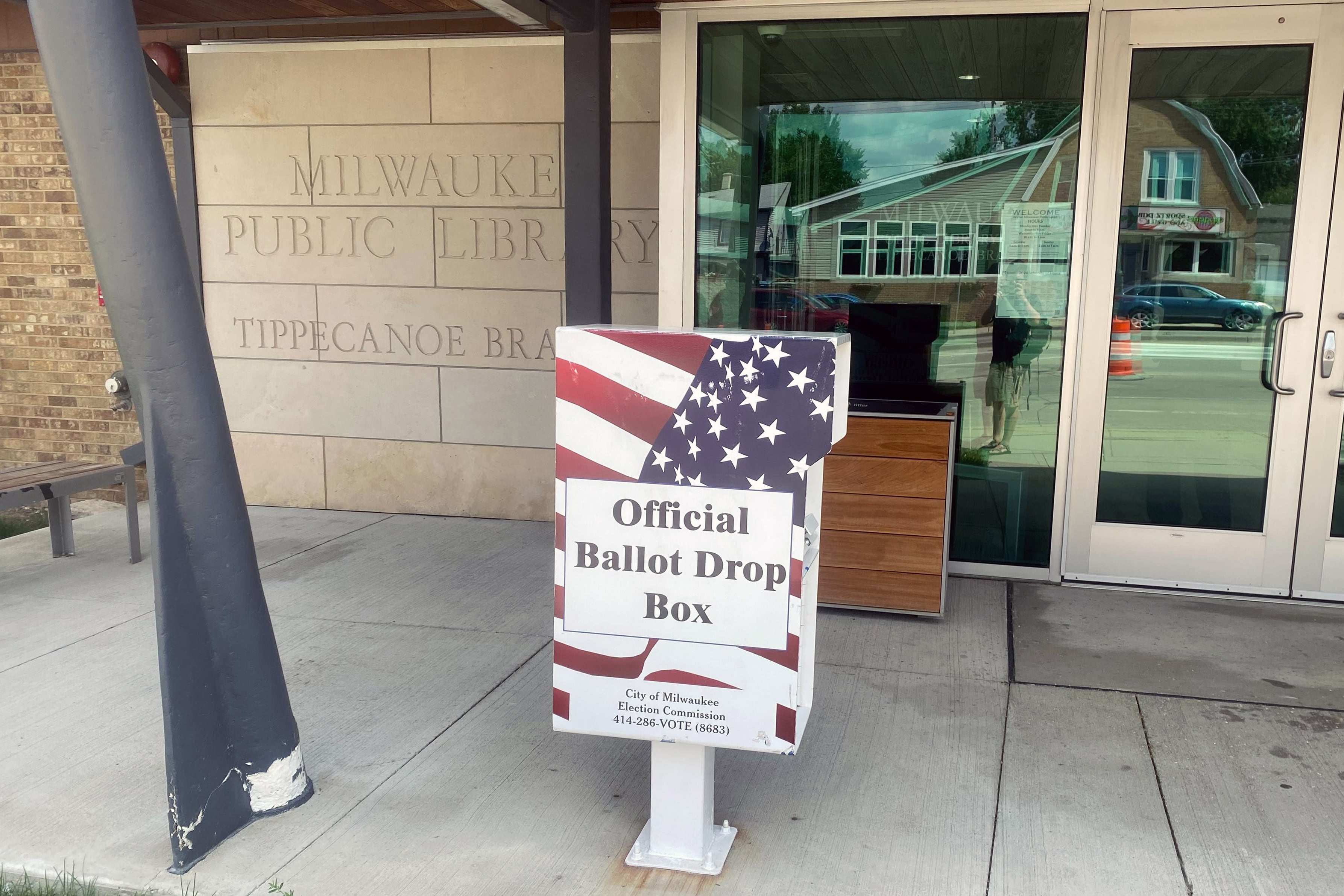Votebeat is a nonprofit news organization reporting on voting access and election administration across the U.S. Sign up for Votebeat Wisconsin’s free newsletter here.
They opened to fanfare, and closed on or just before election day, having fulfilled their purpose. Absentee ballot drop boxes were back in Wisconsin for the first time in over two years, and everything seemed to go just fine.
For Tuesday’s primary, voters in many Wisconsin municipalities had their first opportunity in several elections to return their ballots to a drop box. That could have been at one of the 14 drop boxes in Madison, one of the 13 locations in Milwaukee, the red drop box outside of Racine’s City Hall, or one of the other drop boxes located in places from Onalaska to Rhinelander.
Many municipalities that used to have drop boxes didn’t reopen them for this election for various reasons, from a rusted drop box lock to a lack of time — the Wisconsin Supreme Court’s July 5 decision unbanning them came less than six weeks before the primary. Many of those cities plan to have drop boxes available in November, though.
In the places that offered them for the primary, including Wisconsin’s two biggest cities, clerks reported no significant problems and a fair amount of drop box use, given that the option opened up well after absentee voting was already underway.
“The transition to utilizing drop boxes has been going pretty smoothly thus far, and we hope that that’ll continue in November,” said Paulina Gutiérrez, executive director of the Milwaukee Election Commission.
Voters said drop boxes provided them with an extra path to return their ballots as they juggled challenging work schedules and other obstacles to voting.
Madison resident Quocan Vo works nights, which he said makes it inconvenient to vote in person during the day. He contemplated taking his absentee ballot to a polling place, but said that “defeats the purpose of absentee voting.”
Instead, he took his ballot to a drop box Monday just outside the Willy Street Co-op, becoming one of hundreds of Madisonians to use a drop box this election.
Madison’s drop boxes opened on Aug. 5, eight days before election day and on what City Clerk Maribeth Witzel-Behl calls “Mail-it-back Monday” — the last day by which she said a ballot should be mailed to avoid delays.
The ballots that arrived in drop boxes since that date, Witzel-Behl told Votebeat, “are absentees that maybe otherwise would have been put in the mail and arrived after election day, so wouldn’t have been able to be counted.”
Drop boxes also had steady activity in Milwaukee, Gutiérrez said. The most heavily used drop boxes were those near the busiest early voting sites, she said.
Milwaukee resident Matt Dresen initially sent his ballot in by mail. But it was returned to him on Monday because the envelope lacked a witness address. After fixing the error, he put the ballot in a Bay View drop box on Tuesday, recognizing that his ballot would arrive too late if he tried mailing it again.
Plenty of internal processes to keep drop boxes safe
Some voters have lingering and unfounded suspicions about drop boxes: that they’re not secure, or that they promote so-called ballot harvesting. The doubts have been voiced even by some politicians, like Republican U.S. Senate candidate Eric Hovde, who on Tuesday questioned why Wisconsinites need drop boxes and falsely said they didn’t exist in Wisconsin until the pandemic.
More than half the states in the country expressly allow drop boxes or have jurisdictions that offer them.
In Madison, poll workers followed a meticulous process to make sure absentee ballots deposited at drop boxes were safe.
After 5 p.m. on Monday, when drop boxes closed for the election, poll workers assigned to teams of two loaded ballots from each of the city’s 14 drop boxes into tamper-evident bags, each with unique seal numbers. During the process, they filled out chain-of-custody forms with their names, the time they arrived at the drop box, and the serial number on each bag. They also closed and locked both slots on the drop boxes.
The poll workers then took the secure bags on a short trip to the city clerk’s office, where election workers counted the ballots and confirmed on the chain-of-custody sheet that they accepted the drop box delivery, writing the time they received the ballot bags and noting their serial numbers.
On a few occasions, when they pulled out the ballots, election officials found absentee ballots for different cities, and they arranged to have those ballots delivered to the correct place. They then sorted the Madison ballots by the 108 polling sites and loaded them again into tamper-evident bags with unique seal numbers. Then, on election day, poll workers dropped those ballots off at the correct polling sites, filling out another chain-of-custody form to document their activity. In Madison, absentee ballots are counted at the polling site where the voter would have otherwise cast an in-person ballot.
Election officials in other areas of the state have different processes to keep drop boxes and the ballots deposited in them secure. But across the board, it appeared the absentee ballots deposited in drop boxes passed through fewer hands — and likely fewer cities — than mailed ballots. And they almost certainly took less time to get to clerks’ offices. Election officials have been concerned with mail delivery as they’ve faced lost ballots and mail delays.
Preparing for drop boxes and additional guidance
Rolling out drop boxes required last-minute work from the election officials who decided to offer them in this primary election.
The state high court lifted the ban on them after absentee voting already started on June 27. The Wisconsin Elections Commission issued guidance outlining proper procedures for drop box use about one week after that. Among the guidelines was that voters should return only their own ballot to a drop box unless they’re helping somebody who has a disability or is hospitalized — a new guideline the agency didn’t issue last time drop boxes were in use.
There was talk before the election of outside observers monitoring drop boxes in Madison and other parts of the state to watch for signs of possible or perceived wrongdoing. There was little of that, though November may be a different story.
In Milwaukee, city officials hosted a couple press conferences to highlight drop box use and met with staff from voter-focused organizations to get the message out about proper drop box use, like how voters in most cases can return only their own ballot to a drop box, Gutiérrez said.
Gutiérrez also prepared election workers and staff at libraries, where most of the city’s drop boxes are located, for the possibility of third-party drop box observers.
“We don’t mind observers. They can come and watch,” she said. “We just don’t want them to interfere with the voting process, and we don’t want voters to feel intimidated.”
By Monday afternoon, Gutiérrez said, there were no signs of outside groups interfering with the voting process at drop boxes or any drop box observers that did anything notable.
Milwaukee election officials aren’t obligated to ask any questions to people returning ballots to a drop box, said Gutiérrez, in reference to an additional state election commission guideline.
Even somebody dropping off four or five ballots could be doing so properly because the other ballots could belong to residents of residential care facilities, Gutiérrez said.
“It’s not our discretion to figure it out,” she said. “Of course, if someone gets a complaint, we will investigate as well as we can.”
In Madison, Witzel-Behl typically sends voters a supplemental letter outlining where and how voters can return absentee ballots. But she finalized and began sending out the document before the high court legalized drop boxes.
Still, city officials have tried to alert the public about the new ballot return option. Mayor Satya Rhodes-Conway held a news conference standing beside a drop box on the day they opened.
“We are absolutely committed to making sure that every eligible voter has a safe and secure way to cast their ballot, and drop boxes are, I think, a really key part of that,” she said.
Appearing alongside her were staff members of voter advocacy groups, including All Voting Is Local and Disability Rights Wisconsin, who tried to get the message out about drop boxes since the July ruling.
Drop boxes provide a safe and accessible voting option for people whose disabilities make it difficult or impossible to vote in person, said Anna Anderson, Disability Rights Wisconsin’s voting rights coordinator.
Some Wisconsin voters didn’t yet have access to drop boxes
Madison and Milwaukee each had over a dozen drop boxes in use, while some other cities had just one or none at all.
Wausau officials opted not to open their drop box, partially because of a rusted drop box lock.
Green Bay City Clerk Celestine Jeffreys told Votebeat the city didn’t have enough time to reinstall its drop boxes after the Wisconsin Supreme Court ruling. She hopes to install them in time for the general election, she said.
Beloit City Clerk Marcy Granger said she didn’t use drop boxes in this election because the decision came after she already sent out absentee ballots with an instruction sheet approved by the Wisconsin Elections Commission. The sheet didn’t mention drop boxes as a ballot return option.
Drop box policies also varied among the municipalities using them.
For example, Madison’s drop boxes closed Monday at 5 p.m., while Milwaukee’s stayed open until 6 p.m. on Tuesday.
In Madison, the earlier closure is a function of the way the city sorts absentee ballots and sends them out to polling places for counting.
In Milwaukee, as in other cities with central absentee ballot counting facilities, the process is simpler. Ballots from drop boxes are taken to the city’s single central counting location and counted there along with other absentee ballots. The 6 p.m. deadline ensures that election officials have enough time to collect and count them, Gutiérrez said.
November’s election will be different. Voter turnout will be far greater, drop boxes will be more widely available, and many more ballots will end up in them. And there may well be third-party election observers watching drop box activity, and reporting their suspicions if they see a voter dropping off multiple ballots.
But for the primary, as a trial for the return of a popular voting option during a relatively low-turnout election, it appears drop boxes passed the test.
Alexander Shur is a reporter for Votebeat based in Wisconsin. Contact Alexander at ashur@votebeat.org.






